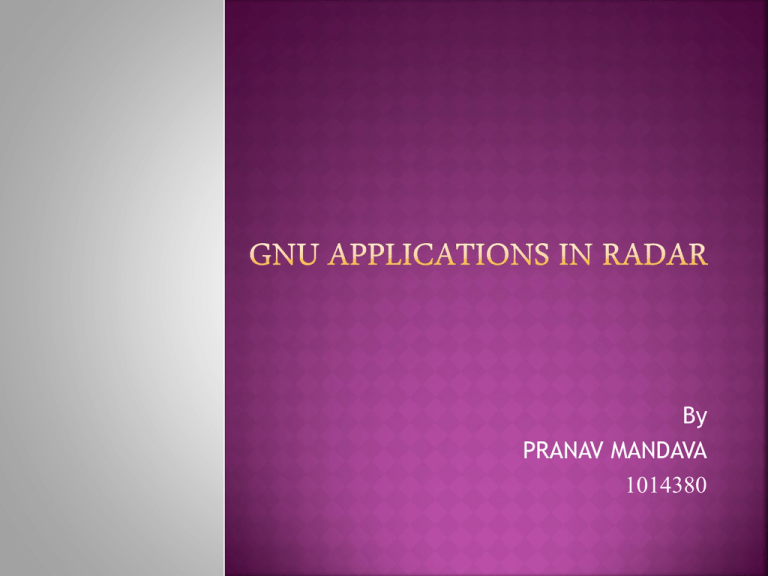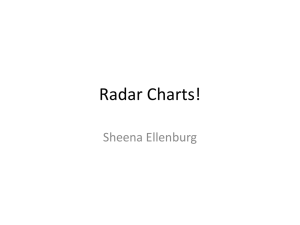GNU APPLICATIONS IN RADAR
advertisement

By PRANAV MANDAVA 1014380 CONTENTS : Introduction to GNU Radio Requirements of Software Defined Radar Architecture of Software Defined Radar Predicted Performance of Software Defined Radar Conclusion GNU Radio is a free software development toolkit that provides the signal processing runtime and processing blocks to implement software radios using readily-available, lowcost external RF hardware and commodity processors. It turns radio hardware problems into software problems. A software-defined radio (SDR) is a radio communication system that performs radio signal modulation and demodulation in software. Block diagram of a currently realizable software-defined radio communication system Applications of GNU Radio o ATSC o RADAR o PAGER RADAR (Radio Detection and Ranging) Radar is a system that uses radio waves to determine and map the location, direction, and/or speed of both moving and fixed objects such as aircraft, ships, motor vehicles, weather formations and terrain. Different types of radars are o Bistatic radar o continuous wave radar o doppler radar o fm-cw radar o mono-pulse radar o passive radar o planar array radar o pulse doppler radar o synthetic radar Requirements: Hardware: performance of the sensor hardware Software: In order to be useful as a radar sensor, the system must be capable of transmitting and receiving data such that the time between pulse transmission and reception can be known exactly. such a system exhibits time coherence and time-synchronization, which are defined as follows. Time-coherence: A stream of digital data samples is said to exhibit time coherence if a time value can be be assigned to each sample such that the difference in the time values assigned to any two samples is equal to the difference between the actual times at which the samples were converted either to, or from, an analog signal. If the system is time-coherent, then the discrete data signal accurately represents its analog counterpart in time. Time synchronization : Two streams of digital data are said to lack timesynchronization if each stream is time-coherent within itself, but the two-streams are not timecoherent with respect to one another. In radar systems, time synchronization must exist between the transmit and receive data streams. ARCHITECTURE: The Transmit Signal Processing Block: This block accepts three arguments The first argument specifies the file that contains exactly one pulse-repetition interval (PRI) of the radar waveform at baseband. The second argument is the number of times the data in this file should be transmitted (i.e., the number of pulses to transmit). The final argument is the delay, specified in number of samples, that the transmitter should wait before transmitting anything. Block diagram of transmitter software algorithm The Receive Signal Processing Block This block accepts four arguments The first argument is a pointer to the transmit block. This pointer allows the two blocks to communicate. The second argument is the file to which the received data should be stored. The third argument specifies how many samples of each PRI should be recorded to file. The final argument specifies the number of samples to be ignored in each PRI until the receiver should begin recording the number of samples specified by the third argument. Block diagram of receiver software algorithm HARDWARE : The daughterboards currently offered by Ettus Research. The RFX2400 2.4 GHz transceiver daughterboard which is used in radar testing. Hardware Transfer Function: Radar Range Resolution: The degree to which a radar system can resolve two targets separated in range is directly proportional to the bandwidth of the radar waveform incident on the target. That is, given a waveform bandwidth of B, two targets can be resolved by the radar if they are separated in slant range by more than where c is the speed of light. PULSE COMPRESSION : A signal processing technique known as pulse compression can be employed to circumvent the difficulties associated with the use of short pulses. Pulse compression involves the transmission of a long coded pulse and the processing of the received echo to obtain a relatively narrow pulse. In the receiver, pulse compression is implemented by correlating the received signal with a replica of the transmit signal. The software-defined radar (SDR) must be capable of performing each of the following tasks: 1. Generating the desired radar waveform in software 2. Passing the generated waveform from software to hardware 3. Transmitting the generated waveform 4. Receiving the return signal 5. Passing the return signal from hardware to software 6. Recording the desired portions of the return signal in software Block diagram of SDR architecture PREDICTED PERFORMANCE : Performance of SDR can be improved by improving these three factors Down-Range Resolution Power Budget Waveform Selection Conclusion: In this presentation I have discussed about applications of Gnu radio in RADAR and architecture of Software Defined Radar’s. REFERENCES :1. A GNU Radio Based Software-Defined Radar by Lee K. Patton Department of Electrical Engineering 2. http://www.wikipediaondvd.com/nav/art/p/t.html 3. http://en.wikipedia.org/wiki/Radar 4. Eric Blossom, “GnuRadio: GnuRadioHardware” THANK YOU





